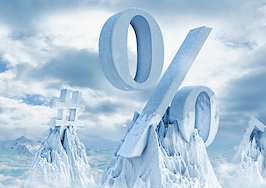The Federal Reserve this month will begin tapering the support it’s provided to mortgage rates during the pandemic, reducing its $120 billion in monthly purchases of mortgages and government debt over eight months.
Because the Fed has been broadcasting its intentions for months, mortgage rates aren’t expected to jump right away, as markets have already priced in the Fed’s tapering plans. But forecasters do expect a gradual rise in mortgage rates next year, as the Fed stops growing its mortgage holdings.
The timetable for tapering announced today fits a scenario discussed at the Federal Open Market Committee’s September meeting, and revealed publicly last month with publication of the meeting’s minutes.
“Beginning later this month we will reduce the monthly pace of our net asset purchases by $10 billion for Treasury securities and $5 billion for agency mortgage backed securities,” Federal Reserve Chairman Jerome Powell said. “If the economy evolves broadly as expected, we judge similar reductions in the pace of net asset purchases will be appropriate each month. Increases in our security holdings would cease by the middle of next year.”
Fed timetable for tapering asset purchases

Source: Federal Reserve Open Market Committee
During the pandemic, the Fed has boosted its holdings of Treasurys by $80 billion a month, while growing its mortgage holdings by $40 billion a month. Although the Fed doesn’t directly control long-term interest rates for mortgages and Treasurys, its asset purchases — dubbed “quantitative easing” when first introduced during the 2007-09 recession — helped push mortgage rates to record lows.
“Our asset purchases have been a critical tool,” Powell said at today’s press conference, helping preserve finance stability early in the pandemic, and since then, fostering economic conditions to support the economy.
Under the schedule announced today, the Fed would end its pandemic quantitative easing program by June. That schedule is not written in stone, Powell said.
“We are prepared to speed up or slow down the pace of reductions in asset purchases if it’s warranted by changes in the economic outlook,” Powell said. “If we feel something like that is happening, we will be very transparent. We wouldn’t want to surprise markets. We will say in light of these factors we are considering doing this and then we would either do it or not do it. But I’m not going to start making up examples of what that might be today.”
Powell was also clear that the decision to taper does not mean the Fed is ready to start raising the short-term federal funds rate. The Fed chairman has previously said that policymakers want to finish tapering before they raise short-term rates.
“The focus of this meeting is on tapering asset purchases, not on raising rates,” Powell said. “It is time to taper we think because the economy has achieved further progress towards our goals measured from last December. We don’t think it’s time to raise interest rates. There is still ground to reach maximum employment both in terms of employment and participation.”
Mortgage rates have been on the rise in recent weeks as tapering appeared imminent. Bond markets took today’s announcement in stride with 10-year Treasury yields — a barometer for mortgage rates — showing little movement.
In forecasts issued in October, economists at Fannie Mae, Freddie Mac and the Mortgage Bankers Association agreed that mortgage rates are headed up next year. But there’s considerable divergence among forecasters over how sharply rates will rise.
Mortgage rate forecasts diverge

While Fannie Mae economists see rates on 30-year fixed-rate loans rising to an average of 3.4 percent during the fourth quarter of 2022, MBA forecasters are projecting that they’ll be at 4 percent during the last three months of next year.
Freddie Mac and the National Association of Realtors are in the middle, predicting mortgage rates will average 3.7 percent during the fourth quarter of 2022.
“This is the first of many actions over the next 24 months that will force up mortgage rates,” said Lawrence Yun, chief economist for the National Association of Realtors, in a statement. Interest rate hikes are coming in 2022, he said, “due to persistently high inflation.”
The timing and amount of tapering announced by the Fed “are in line with market expectations,” MBA Chief Economist Mike Fratantoni said in a statement.
“As the Fed’s actions were anticipated, this announcement will not impact our latest forecast for mortgage rates and mortgage originations,” Fratantoni said.
Rising mortgage rates are expected to put a damper on a refinancing boom that allowed 8.8 million homeowners to refinancing their mortgages at lower rates during the last 18 months, saving them $16 billion a year in interest, according to a recent Black Knight analysis.
In the near term, rising mortgage rates could help cool overheated home price appreciation, but some experts have warned that a sustained run-up in mortgage rates could also dent home sales.






